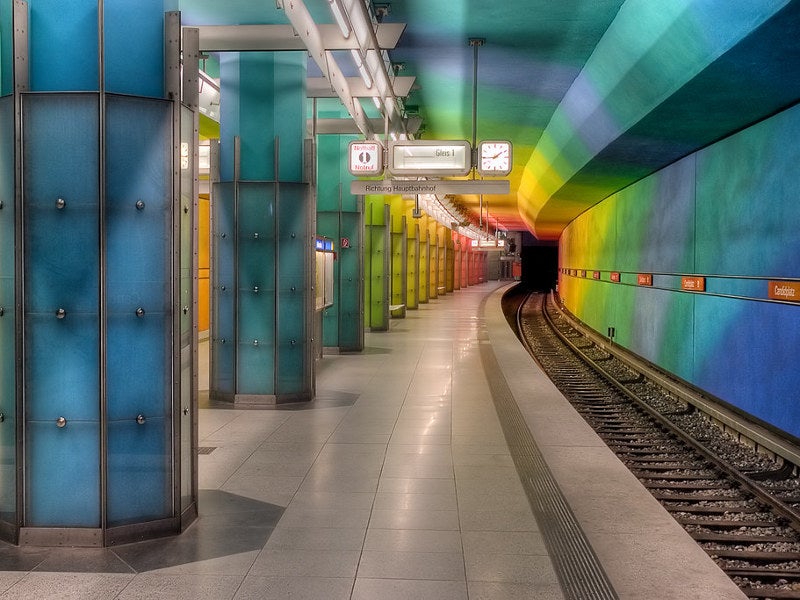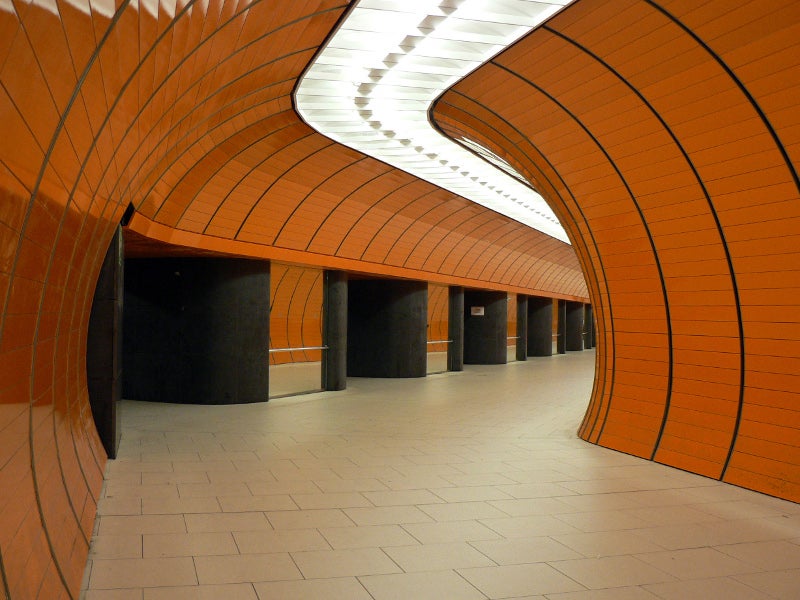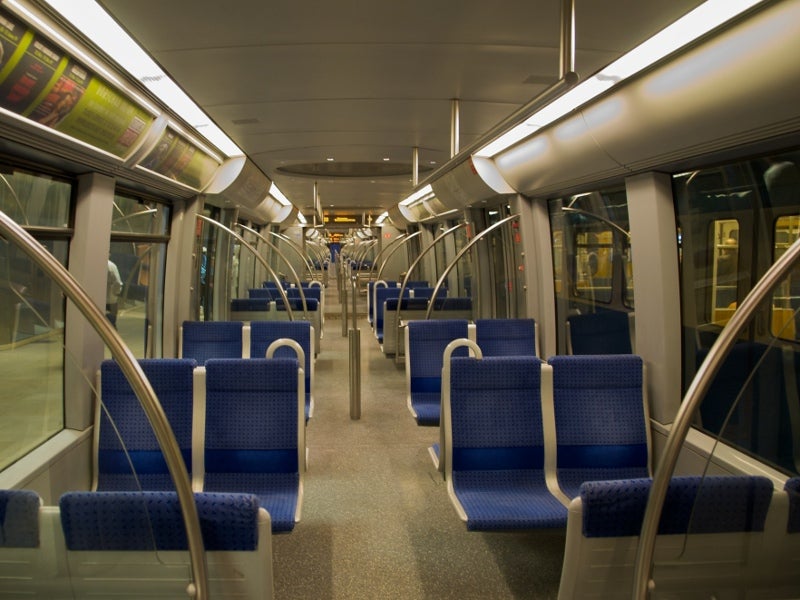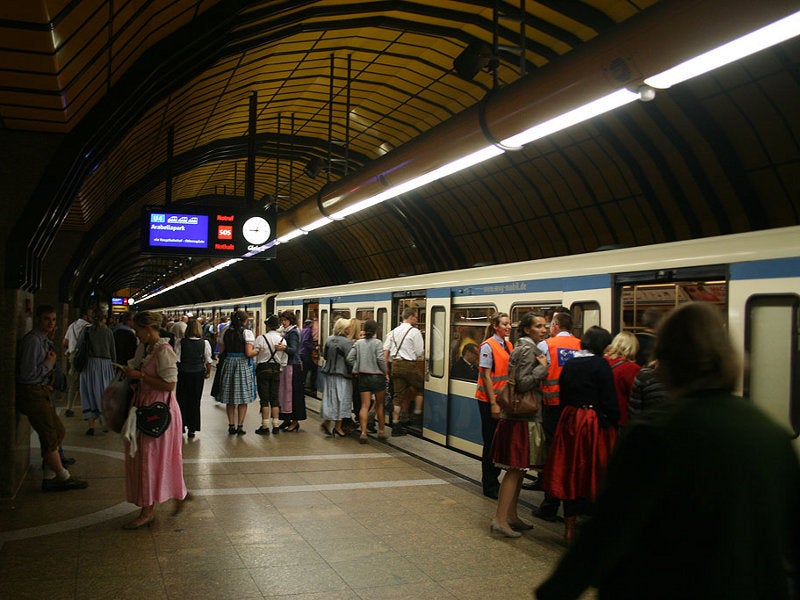München U-Bahn is an underground rapid transit network serving München (Munich), the capital city of Bavaria, Germany. Maintenance and operations of the network are carried out by Münchner Verkehrsgesellschaft (MVG).
The subway transport network began its operations in October 1971 and runs for 103.1km. It has eight lines with 100 intermediate stations with interconnections to the S-Bahn system. In addition, it has a booster line that operates during peak traffic times.
Daily ridership of the subway network is approximately 1.3 million.
History of München’s rapid transit network
Trams were the primary mode of transportation in München in the 1930s.
The city planned to extend its tramway network but shelved it because of the outbreak of the Second World War. When the proposal was floated again in the 1960s, the city authorities changed the plans to building an underground subway metro network rather than extending the existing inefficient tram network.
In 1966, construction of the subway metro network commenced to provide improved transportation for the 1972 Olympics. The first line of the metro network stretching 12km from Kieferngarten to Goetheplatz (Line U6) was inaugurated in October 1971. Another line between Münchner Freiheit and Olympiazentrum (Line U3) was opened in May 1972.
The network was extended regularly and new lines were constructed over time to make up the current subway network.
München U-Bahn lines
U1 is a 12.2km-long stretch in the München subway network. Starting in the Moosach district at Olympia-Einkaufszentrum, the line passes through 13 intermediate stations and terminates at Mangfallplatz. The last extension of the line was a 0.5km stretch from Georg-Brauchle-Ring to Olympia-Einkaufszentrum in 2004.
There are plans to extend the line U1 further from Mangfallplatz to Laurinplatz through Harlaching Hospital to the south in future.
U2 is a 24.4km-long line between Feldmoching and Messestadt Ost. The line starts at the Feldmoching quarter and passes through eight intermediate stations before terminating at Messestadt Ost. The line has witnessed the highest number of changes compared to any other line in the network. It was previously designated as U8.
U3 is a 21.44km-long stretch in the subway network. It starts at Moosach and passes through 22 intermediate stations before terminating at Fürstenried West. A 2km extension of U3 from Olympia-Einkaufszentrum to the current terminus Moosach was opened in December 2010, bringing the total number of stations in the whole network to 100.
U4 is a 9.3km line between Westendstraße and Arabellapark. It passes through 11 intermediate stations and is the shortest line of the network.
U5 is a 15.43km route between Laimer Platz and Neuperlach Süd. It passes through 16 intermediate stations. Plans to extend the line further west are underway. The line is scheduled to be extended from the current terminus Laimer Platz to Pasing Bf through Willibaldstraße and Am Knie.
U6 is a 27.41km-long stretch between Garching-Forschungszentrum and Klinikum Großhadern. It passes through 24 intermediate stations and is the oldest line of the network. Proposals for the extension of the line from the current Klinikum Großhadern south terminus to Martinsried were approved in July 2009 with an investment of €67m ($86.8m).
U7 is a booster line of the subway, which was reintroduced into service in December 2011, after it had been closed for approximately five years. It runs between Westfriedhof and Neuperlach Zentrum. It helps to manage traffic during peak hours, especially between 7AM and 9AM for school transportation.
U8 line is also a booster line that runs along Olympiszentrum – Scheidpaltz – Hauptbahnhof route. It only runs during Saturdays and serves nine stations on U2 and U3 lines.
New U9 line
A new 10.5km-long U9 underground line will run along the route of Impler / Poccistraße – Esperantoplatz – Central Station – Pinakotheken – Elisabethplatz – Münchner Freiheit.
An additional line linking Hauptbahnhof – Theresienstraße, to be named U29, will also be built. The main station of the line will have an additional subway station along with transfer options for the second main line.
The line is expected to be fully automatic and is scheduled to start its operations between 2035 and 2040.
Rolling stock for Munich’s underground subway
The network operates more than 550 trains of Class A, Class B and Class C rolling stock types. Class A trains are 37.15m long, 3.55m high and 2.90m wide. They have six doors on each side and a seating capacity of 98, in addition to standing room for 192 passengers.
Class B train sets have dimensions similar to those of Class A but run on a three-phase current, unlike class A, which operates by means of a direct current motor.
Stadtwerke München awarded a €185m ($240m) contract to Siemens Mobility for the manufacture of 21 six-car units of Type C2.11. Some of these units will replace the 40-year-old Class A rolling stock on the subway network. The maximum speed of the new rolling stock is around 80kmph to 90kmph.
Two more options were included in the contract to order an additional 23 six car train sets for delivery in 2016 and 2020. Plans are in place to replace approximately 60% of the network’s existing fleet by 2025.
A sample C2 train set was unveiled in October 2012, and the first of 21 six-car trains entered passenger service in June 2016 on the U6 line between Kieferngarten and Garching Forschungszentrum. The train has 220 seats with a capacity to carry 720 passengers.
Signalling and communications
The trains can operate in two modes, FO and LZB. FO mode will allow manual operation and control using visible signals. LZB mode will involve operation of the train automatically using control signals generated by an induction loop.
Future for the Bavarian rail network
MVG announced plans to invest €70m ($90.7m) to renovate the metro network. These renovations include modernisation of Hauptbahnhof and Marienplatz railway stations, upgrading signalling at Scheidplatz, the installation of advanced power supplies for supporting two-minute headways from 2014, upgrades to fire protection facilities, adding lift and escalator facilities and installation of passenger information systems.
Sendlinger Tor subway station will be refurbished and modernised as it is a bottleneck in the subway network. The project will include redesign of the station, reorganisation of operating rooms and sales areas, and expansion of retail space.
Related content
Berlin U-Bahn Upgrading, Germany
The city-state of Berlin has a long-established underground network, with the first trains running in 1902.
Hamburg S-Bahn Rail Network Project, Germany
Germany’s second-largest city, the city-state of Hamburg (Freie und Hansestadt Hamburg) is the country’s leading port and a commercial, manufacturing and media centre.
Dortmund and Düsseldorf H-Bahn Systems, Germany
The H-Bahn systems in Dortmund and Düsseldorf, Nordrhein-Westfalen (NRW), Germany are both of the SIPEM type (Siemens People Mover).
Bombardier Movia Metro Cars, Germany
MOVIA metro cars, which are manufactured by Bombardier Transportation to provide a safe and cost-efficient service, are currently operational in a large number of metro rail networks across the globe.





